Verdict
Doom: The Dark Ages is a heavyweight shooter that, at its core, is lighter on its feet than its predecessor. However, id has at times gone too wide with its half-baked new features and open level design. Rip and tear, until it is done. But please, Slayer, get out of the damn robot.
Doom is at its best when id Software is innovating. This is, for the most part, a universal truth for the rip-roaring, genre-defining series, and its reboot trilogy hasn't betrayed that spirit. Doom 2016 was a rapturous return to form after a decade-long hiatus; a tightly crafted shooter, quintessentially 'Doom,' that upgraded Doomguy's credentials from 'unlucky marine' to 'mythical god-slaying entity.' 2020 brought Doom Eternal, which essentially strapped rockets to the Slayer's size 50-odd boots and set him on an assault course, splitting fan sentiment. id's latest shake-up is Doom The Dark Ages, a far darker, medieval-infused prequel that acknowledges the studio may have gone too hard with its predecessor. While id has once again overstretched at points, The Dark Ages lends plenty of credence to my opening statement.
Chronologically, FPS reboots. However, the divine Makyrs, wary of his supreme power, have him on a tight leash – the kind that would kill even him should he go rogue. As the war rages on between the humanoid Sentinels of the dimension Argent D'Nur and the inhabitants of hell, led by Prince Azhrak, the Makyrs deploy the Slayer like purgatory pest control whenever things get a little dicey. The Slayer is immediately established as the hydrogen bomb, while quite literally everything else, from hell to the cosmic realm, is the coughing baby.
Doom 1993 lead programmer John Carmack once famously likened the importance of videogame stories to adult movie preamble, compared to the importance of gameplay. While each iteration of Doom has continued to espouse best-in-class gunplay, a major critique of the reboot series comes from how it has embraced modernity in progressively pushing harder for narrative.
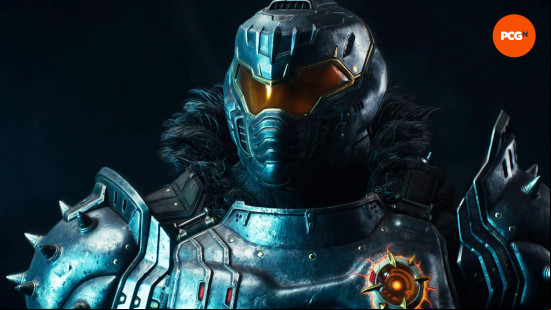
The Dark Ages is, perhaps, the final form of this transition, with id tossing you almost entirely out of the codex and into the cutscene. If 'they killed his rabbit and he likes saving people' is all the raison d'être you need, you can safely skip these and get back into the action – you're not being force-fed here, and I'd rather this approach than having to pore over data logs to understand what's going on. If you are even tangentially interested in Doom's broader lore, you're in for a far broodier narrative this time around. Though a fairly substantial amount of time is devoted to fleshing out the Slayer's ing Sentinel ensemble, something I wasn't particularly fussed about, there's plenty of Doomguy glazing going on that only enhances his mythos. Eagle-eyed vets will also spot a few well-placed throwbacks to Doom's past, so maybe don't skip all the cutscenes.
Considering its extraterrestrial setting, id gets quite a lot of creative breathing room with its interpretation of 'The Dark Ages.' In Argent D'Nur, futuristic elements are anachronistically contrasted against the burnished metal of the Medieval period. It's as if Tony Stark took a wrong turn in the quantum realm, ended up in an episode of Game of Thrones, and decided to stick around. The cosmic realm, meanwhile, is considerably more eldritch in design, with big squiddy boys adorning the walls. While Eternal went all out to embellish its environs with the bio-mechanical motifs of H.R. Giger – a major influence on Doom's visual style since the original game – The Dark Ages leans more heavily than ever into its Lovecraftian roots.
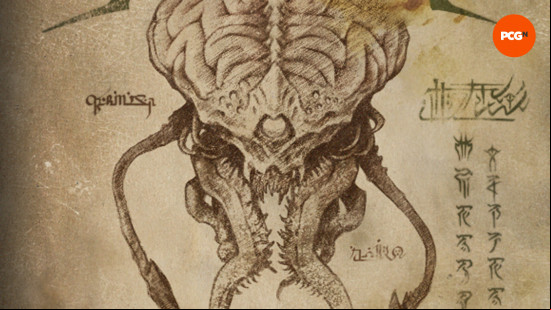
This is also reflected in its enemy design, with the Cacodemons and Barons of Hell receiving the most notable switch-ups. The cyclopean meatballs now sport a much meaner facia, and have sprouted tentacles à la Doom 3, while the now-Cosmic Barons trade horns for fleshy hoods, and arms for freakin' sword arms. There are plenty of new faces to enjoy filling with lead, plasma, and bone, too, such as the mighty Agaddon Hunter, which seemingly is to The Dark Ages what the Marauder was to Eternal.
All of this is beautifully rendered in id Tech 8, the latest version of id's proprietary engine that has opened up a realm of technical possibilities. One of my major concerns in the lead up to The Dark Ages was whether the introduction of larger maps, made possible by the engine's ability to handle more entities than ever, would blur the moment-to-moment combat Doom is renowned for. At times, I felt id had gone too wide as I wandered aimlessly in search of something new to kill, serenaded only by the 40K Space Marine-esque thudding of the Slayer's boots pummeling the ground into submission. But for the most part, these sprawling segments are well-populated and keep you locked in.
During my downtime, I cased the ts for the usual assortment of hidden ages and environmental puzzles, including some pesky Doom The Dark Ages skins that provide an alternative way to slay. ittedly, these didn't always feel particularly 'secretive.' The automap automatically tags every item you trudge within radius of, and even the purple secret keys emit what can only be described as a bat signal, making their location clear. The days of disappearing walls and shadowy ages that force you to scour every pixel of a map have been gone for some time, and while it makes sense insofar as maintaining level flow on massive maps, I wish I had to work even a little harder to earn the goods.
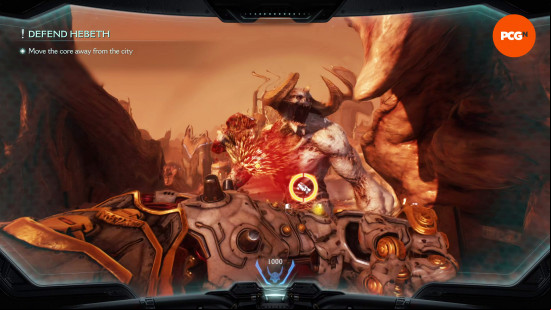
Secret sidequesting isn't the only way id combats downtime between areas. Eternal's transitory platforming sections have, in places, been replaced by The Dark Ages' spectacular setpieces: the Atlan mech and Serrat, the Slayer's pet cybernetic dragon. The former evokes the feeling of riding the Brumak in Gears of War 2, though rather than blitzing Corpsers, you're jamming your village-sized fists through the skulls of titans for fun. It's all simple: punch repeatedly to charge a special bar, then unleash a powerful finisher. Occasionally, a drop pod gives you a meaty machine gun to mow them down. Game director Hugo Martin's work on Pacific Rim is clear to see, as the Atlans look and feel awesome to pilot. Unfortunately, combat is one-note, and after a couple of these instances, I wished I could eject myself from the cockpit and return to the fight on foot.
It's a similar story for Serrat. The jet-powered dragon's slice of the action pie has you fly it through repetitive sections, dodging turrets and other threats to supercharge its weaponry, before unloading on the enemy defenses. It's all clunky and half-baked, which is a shame. Both additions are a major improvement over Eternal's platforming insofar as spectacle, but they ultimately lack enough substance to retain my interest beyond the initial testosterone hit. The good news is that my disappointment was always swiftly forgotten after the Slayer touched down, because Doom The Dark Ages' ground combat is a continuation of what id does best – rip and tear, baby.
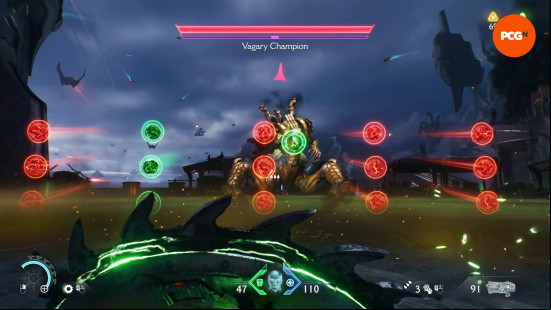
Before that, though, let's start at the not-so-pointy, actually more rounded end of things. The Slayer has a shield now. I know, this may be a lot to take in. But bear with me because it's metal as hell, and opens up a brand new playstyle for our tight-lipped protagonist. As Martin has previously remarked, in Doom 2016 you 'run and gun,' in Eternal you 'jump and shoot.' In The Dark Ages, you 'stand and fight,' utilizing the shield (which is also a chainsaw) to render your opponents completely useless. It's a different kind of power fantasy, but id's take on reactive gameplay is equally as sadistic and satisfying to execute as Eternal's ruthless aggression.
Block, parry, slam, and throw. These are the functions you'll have to get used to as you maraud across the 22 Doom The Dark Ages missions. If the enemy fires a green projectile, you can parry it back towards them – the window of which is incredibly generous, even on Ultra-Violence difficulty. If the projectile's red, block it or dodge. No weak points, just bide your time and strike. Surviving's still easier said than done, so don't expect the shield to paper over your skill issues.
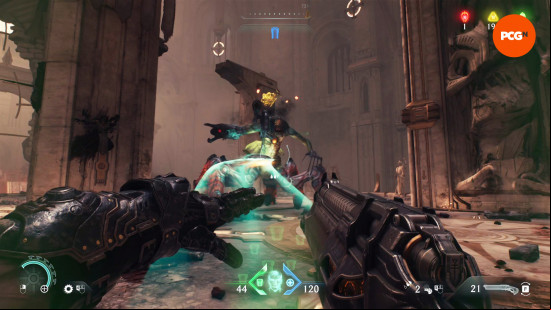
With the removal of Eternal's dash, The Dark Ages' innate pacing is brought back in line with 2016's, and by extension, the OGs. But id isn't ready to give up on its mobility quirks just yet, which is a relief considering how large some of the arenas can be. The shield slam locks you onto a target before the Slayer launches himself at them, creating a seismic thud at the point of that sends out a shockwave. This more conditional approach to getting around quickly is handy for pursuing mobile targets or leaping out of trouble. It's here that I'd perhaps suggest the 'stand and fight' descriptor isn't entirely accurate, because you're still more than capable of taking the fight to the hellish horde – 'seek and destroy' is, at times, a better fit.
Then there's the shield throw. The Captain America comparisons have been constant since the shield saw's reveal, and the Slayer using it like an oversized frisbee won't beat the allegations. Lobbing it at fodder will instantly give them the 'Darth Maul in The Phantom Menace' treatment, though larger enemies have a bit more heft to them. Instead, the shield makes a fleshy home for itself, locking them in place while you deal with the small fry.
As the defining pillar of The Dark Ages' combat, the shield saw is intricately intertwined with its most offensive tools. While quickswapping between weapons has been severely nerfed from Eternal to the point that it's just 'swapping' now, this is a necessity to counterbalance the seamless combo potential you have between gun and shield. Parry, shoot, slam, shoot. Rinse and repeat until suitably maimed. The expressiveness of Doom's combat is still there, just shifted around a bit. It's a lot of change, but when it clicks, it feels phenomenal, bolstered by every strike and defensive action's thunderous clang.
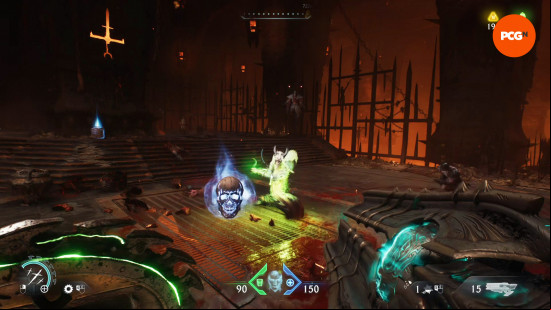
The feel-good factor carries over to The Dark Ages' inventory of destruction, which is suitably stocked with plenty of familiar firepower, such as the super shotgun. Doom The Dark Ages' weapons now come as a class pair, which you can switch between with a different keybind, smoothing the transition between guns even further. The noble plasma rifle, for example, now comes as the standard Accelerator, alongside its big brother, the double-barreled Cycler. The more Medieval additions, particularly the bone-chewing Pulverizer and ball-and-chain-firing Chainshot, are some of my favorite designs to grace the series.
Though id has done away with enemy-specific weak spots, you'll still need to find the right tool for the job. Some enemies have plasma shields, which the Accelerator excels at dealing with. Others are armored and require a bludgeoning from the Chainshot to strip their protective layer away. Despite this, I felt that certain weapon family simply weren't as useful as their siblings, leading me to disregard them. I seldom lacked ammo (Eternal enjoyers, we're eating good), especially as I unlocked more means to generate it through the Doom The Dark Ages upgrades system, so there was never an impetus to use them.
This, however, can easily be remedied by knocking the 'resource values' setting down a notch or two in The Dark Ages' expansive difficulty menu, which lets you tweak everything from the size of the parry window to game speed to enemy aggression.
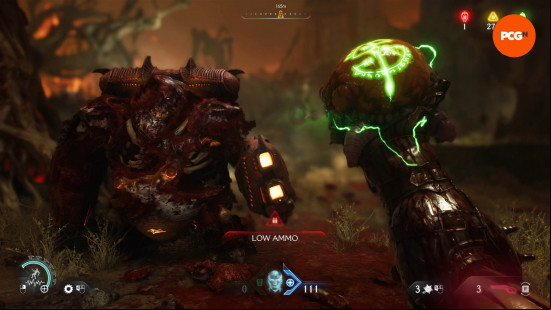
Doom Eternal tried to get too fancy with its myriad combat systems. This plastered a dream skill ceiling for diehards, and forced you to get good or perish, but was perhaps too convoluted for most. Now, it's been peeled back. The flame belch and grenades have been given the chop, while glory kills, and blood punch by extension, have had a major rework.
Don't worry, pearl clutchers, glory kills are still very much part of the experience, but they no longer keep you locked into long animations – they're now more 'Brutality' than 'Fatality.' This not only smooths out the flow of combat but also removes crutching on i-frames to avoid taking damage (use the shield!). The animation variety has unfortunately taken a dip, and what is there generally lacks , yet there are a few cracking (and crunching) finishers to enjoy. Plucking the core out of a large demon's chest and watching it meekly beg for mercy before the Slayer crushes it in his meaty palm is a personal favorite.
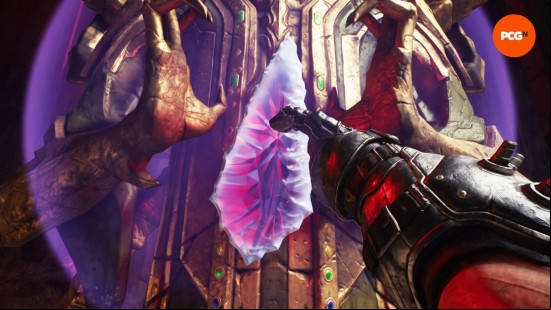
id's also been busy tidying up its progression systems. Praetor Suit upgrades and combat points are gone, while runes have been restricted to quirky, albeit superfluous, shield add-ons that reward you with a unique ive activation for perfectly parrying attacks. Throughout The Dark Ages, you'll only be upgrading your weapons (including the trio of melee options) and shield, and you'll only need three currencies to do it: Gold, Rubies, and Wraithstones.
Between the shield saw that operates on a context-sensitive control scheme, and the refocusing of multiple systems, it's easy to see why Martin previously likened The Dark Ages' gameplay to a guitar with fewer strings. You only need four chords to make a chart-topping hit.
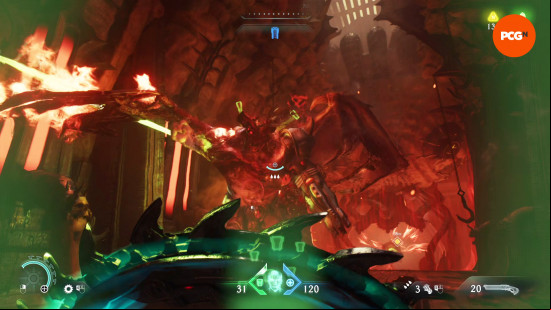
On that musical note, it's worth utilizing this convenient analogy as a segue to address the other, less shield saw-y elephant in the room. Doom's music is intrinsic to the experience in the way it wills you forward with its big, energetic riffs, and it's been that way since Bobby Price brought us to Doom's Gate. Mick Gordon's innovative approach to using chainsaws in industrial synth-driven bangers aligned him perfectly with id's series reinvention; a match made in hell. After a messy divorce between artist and studio saw the end of Gordon's involvement, a poison chalice was left on the table.
Finishing Move (Borderlands 3, The Callisto Protocol) has since taken up the goblet and guzzled down the organ-vaporizing Kool-Aid, and the outfit's done The Dark Ages' soundtrack justice. There's plenty of that godly guttural chug that Gordon brought to the fore, and while there aren't any modulated power tools on this one from what my untrained ear can tell, the group has channelled instruments like the Tagelharpa (*Witcher 3 OST intensifies*) to bring about a more traditional, historically appropriate metal fusion. Give yourself five minutes with the main menu theme and you'll hear what I mean.
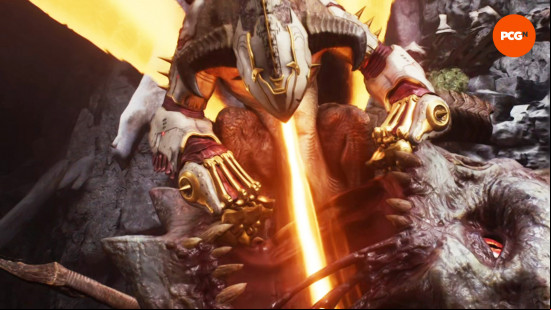
Bemusingly, my only criticism of The Dark Ages' music is that it feels like there's not enough of it. Between the game's first and final missions, I encountered plenty of instances where the juice sat far too low in the mix of everything else going on, to the point that I had to do some volume bar wizardry to give it a chance to shine. Additionally, there were larger encounters where the music didn't seem to trigger at all. Please, id, I yearn for more.
Doom The Dark Ages has only reinforced my belief that id is at its best when it keeps things tightly focused. Doom has gradually shifted itself from what old heads would consider 'proper,' but not in a way that indicates it's having a mid-life crisis. Sure, the Slayer's gone out and gotten himself a super-fast sports dragon, but the slaying is as cerebral as ever, the shield saw is an inspired addition, and id has done a tremendous job of separating the wheat from the chaff. It's just a shame some of the latter has been tacked back on elsewhere. That said, The Dark Ages is a size 50-ish step in the right direction for the core experience, and I remain confident id will eventually find that perfect balance with modern design sensibilities as it continues to innovate.
